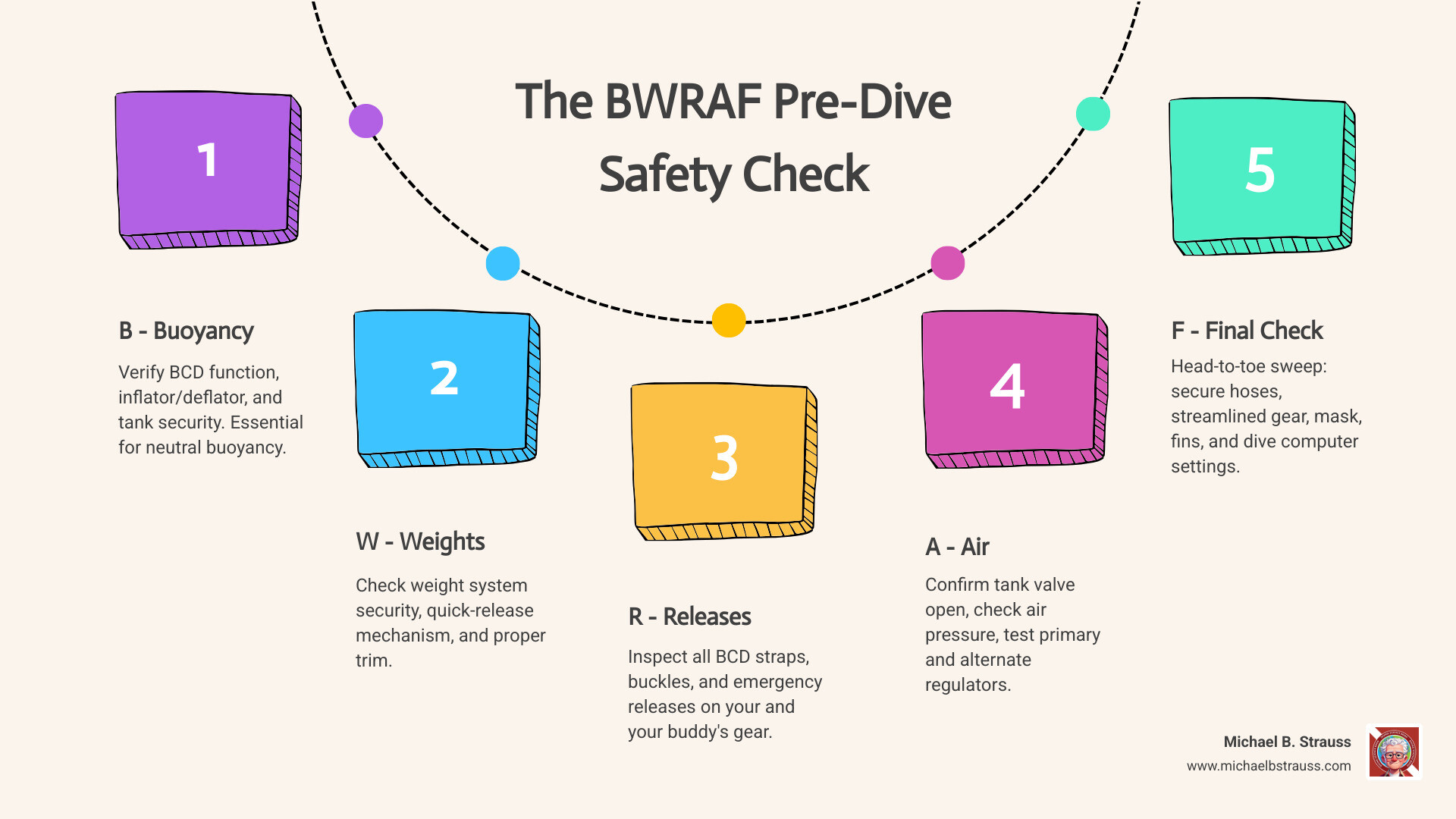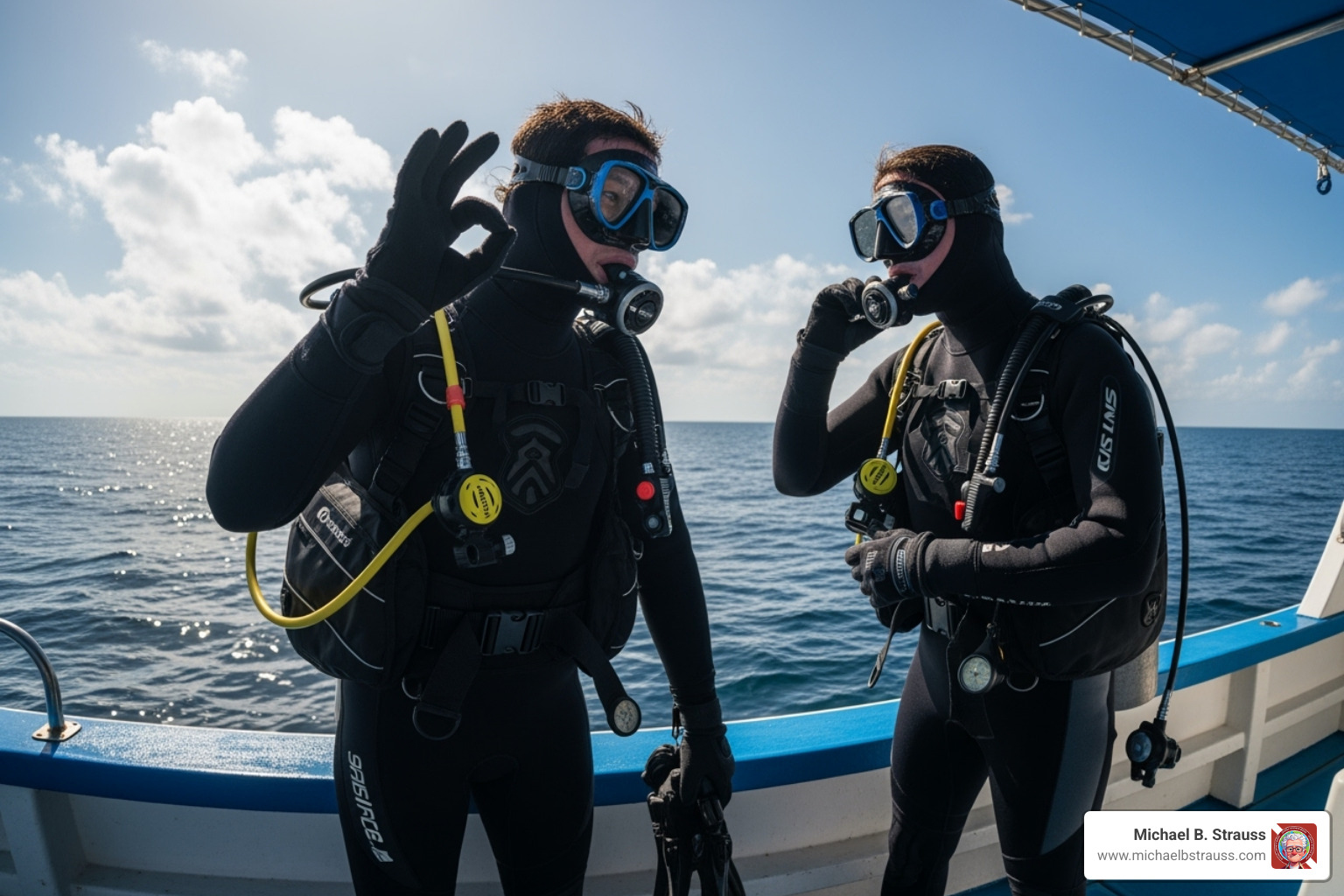Why a 2-Minute Check is Your Most Important Dive Skill
A pre dive safety check is a systematic equipment inspection performed by dive buddies before entering the water. This essential procedure takes only 1-2 minutes but can prevent up to 50% of diving accidents, according to the Divers Alert Network (DAN).
The BWRAF Pre-Dive Safety Check includes:
- B - Buoyancy Control Device (BCD)
- W - Weight system
- R - Releases
- A - Air supply
- F - Final check
Just as airline pilots use a pre-flight checklist, divers must check their life support system before every dive. Complacency can affect even experienced divers. According to DAN research, accidents are just as likely to happen to new divers as to those certified for years. Our brains often see what they expect, making a buddy's fresh eyes crucial for spotting overlooked issues. Most problems underwater begin on the surface; a simple buddy check can be the difference between a great dive and a dangerous one.

Learned during open water diver certification, the BWRAF check is a foundational skill. It builds habits, fosters communication, and creates redundancy. It's far easier to fix a problem on the surface than to manage a crisis underwater. This check should be performed before every single dive.
B - Buoyancy: Your First Line of Control
The 'B' stands for your Buoyancy Control Device (BCD), which manages your position in the water. A malfunction can lead to uncontrolled ascents or descents.
Here's how to check the BCD:
- Connections: Ensure the low-pressure inflator hose is securely connected to the BCD (and dry suit, if used).
- Inflation/Deflation: Test the power inflator button. Then, test all deflation mechanisms, including the oral inflator and all dump valves, ensuring they don't stick.
- Straps and Security: Check that all BCD straps are adjusted and the tank is securely fastened to the BCD.
- Familiarization: Show your buddy where your inflator and dump valves are located and how they operate.
W - Weights: Getting the Balance Right
'W' is for Weights, which help you descend and stay neutral. An improperly secured system can lead to a dangerous, uncontrolled ascent.
Here’s what to check:
- Amount and Type: Confirm you and your buddy have the correct amount of weight and identify the system type (integrated, belt, etc.).
- Security: Ensure integrated pockets are locked in or that a weight belt is snug and properly fastened.
- Quick-Release: Verify the quick-release is secure but can be operated easily with one hand. For belts, this is typically a right-hand release.
- Buddy Familiarity: Know how to release your buddy's weights in an emergency, and vice versa. This knowledge is critical, as an un-ditchable weight system can worsen diving medical issues, a topic covered in Evaluation and Management of Pain-Related Medical Problems of Diving.
R - Releases: Your Emergency Egress Plan
'R' stands for Releases. This step involves checking all buckles and straps that secure your gear, ensuring you can remove it quickly in an emergency.

Here’s what to inspect:
- BCD Releases: Check the shoulder, chest, and waist straps/cummerbund. Ensure they are secure but can be unclipped easily.
- Weight System Releases: Re-confirm the weight release is accessible and functional.
- Other Clips: Secure any dangling accessories like gauges or alternate air sources.
- Buddy Knowledge: Make sure you and your buddy know how to operate each other's releases. This allows for swift assistance if needed.
How to Perform the BWRAF Pre-Dive Safety Check Step-by-Step
Now we move to the heart of our life support system: the Air supply and a comprehensive Final check. These steps confirm our breathing gas is ready and all equipment is integrated for the dive. This systematic approach is a core skill from foundational scuba courses, connecting to broader concepts in Diving Science where understanding equipment is key.
A - Air: The Most Critical Check
'A' stands for Air. A reliable breathing gas supply is non-negotiable. This check ensures your life support system is functioning flawlessly.

- Valve and Pressure: Ensure the tank valve is fully open. Take a few breaths from your primary regulator while watching the Submersible Pressure Gauge (SPG). The needle should remain steady; if it drops, the valve isn't fully open. Confirm you have enough air for the planned dive.
- Breathing Test: Breathe from both your primary regulator and your alternate air source. The air should flow easily and have no taste or smell. Any issues mean the dive is on hold until fixed.
- Secure Alternate: Make sure your alternate air source is securely fastened in the visible, accessible "golden triangle" between your chin and lower ribs, and show your buddy where it is.
The air check connects to principles in Decompression Science, where gas management is critical.
F - Final Check: The Head-to-Toe Sweep for a Perfect Pre-Dive Safety Check
'F' is for the Final Check, your last chance to catch anything missed. This is a head-to-toe sweep to ensure you're ready.

- Streamline Gear: Secure any dangling hoses or gauges to prevent snags and protect the marine environment.
- Mask and Fins: Ensure your mask is defogged and properly fitted. Have your fins ready for entry.
- Computer and Instruments: Verify your dive computer is on, in the correct mode (e.g., Nitrox), and has sufficient battery. Check all other instruments.
- Accessories: Check that lights, cameras, and safety devices are functional and secured.
- Final Look & OK: Do a final visual inspection of your buddy from head to toe. Confirm dive plan and hand signals, then exchange a clear "OK" signal. This isn't a casual "you good?" but a deliberate confirmation that you are both ready.
Common Mistakes and Adapting Your Pre-Dive Safety Check
Even with a system like BWRAF, common traps exist. Complacency and rushing are the biggest culprits, leading divers to take dangerous shortcuts. Our brains tend to see what we expect, which is why a buddy's objective check is so vital.
Specialized diving requires adapted checks. For dry suit diving, you must also check the inflator hose, inflation/deflation systems, and exhaust valves. Technical and rebreather diving involve far more complex equipment and have their own extensive, mandatory checklists that go well beyond BWRAF.
Other acronyms exist, but consistency is what matters:
| Acronym | Steps Covered | Notes |
|---|---|---|
| BWRAF | Buoyancy, Weights, Releases, Air, Final | Widely used, easy to remember |
| ABCDE | Air, Buoyancy, Clips, Dive computer, Everything else | Alternative structure |
| BAR | Buoyancy, Air, Releases | Simpler, but less comprehensive |
| SEABAG | Site, Emergency, Air, Buoyancy, Accessories, Go | Broader context |
The goal is a systematic, collaborative pre dive safety check that catches problems before they become emergencies. No matter your experience level, shortcuts aren't worth the risk.
Beyond BWRAF: Advanced Safety Insights and Final Thoughts
The pre dive safety check is more than a checklist; it's the foundation of smart diving and accident prevention. Skipping this step can turn minor gear issues—like a partially open tank valve or a loose weight pocket—into life-threatening emergencies underwater. The two minutes you spend on the surface can prevent a crisis below.
The magic of the buddy check is that it turns our brain's limitations into a strength. We often see what we expect to see, but a buddy provides a fresh set of eyes to catch problems we might miss. This collaborative process builds familiarity with each other's gear, strengthens communication, and fosters the trust needed for a safe and enjoyable dive.
Risk reduction in diving is about building consistent habits and safety redundancies. The pre dive safety check accomplishes both, creating a routine that catches problems before they escalate. The best rescue is the one that never has to happen.
For divers seeking to deepen their understanding of these principles, the resources available through diving science and safety protocols offer expert insights. Dr. Michael B. Strauss's work emphasizes how combining proper safety habits with an understanding of diving science creates the most reliable foundation for underwater exploration.
Make the commitment: no shortcuts, no matter how experienced you are. A systematic check like BWRAF should be as automatic as putting on your mask. Those two minutes are not just about equipment; they're about ensuring you and your buddy surface safely, ready for the next adventure.
For a comprehensive exploration of these topics, get your copy of Diving Science, Revisited.
DISCLAIMER: Articles are for "EDUCATIONAL PURPOSES ONLY", not to be considered advice or recommendations.






